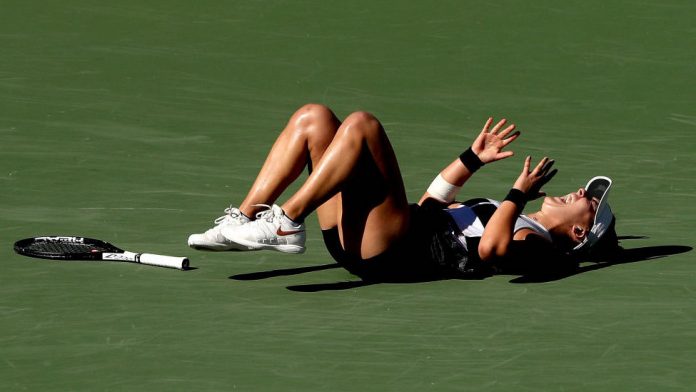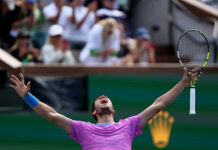
Bill Simons
Indian Wells
Bianca Andreescu is into something called Creative Visualization. She must have had some vision at the beginning of the year. Back then she was just another eighteen-year-old with a lowly 152 ranking who left the Aussie Open after scoring just one win. She was hardly on Angie’s list of feared opponents.
But since then, the creative newcomer has scored more wins than anyone else on the WTA Tour. She’s taken down Venus Williams, Caroline Wozniacki, Elina Svitolina, Garbine Muguruza and Dominika Cibulkova, and reached the semis of Acapulco. She’s the first woman wildcard to reach the BNP Paribas Open finals, and the youngest finalist since 2001.
Andreescu told us that, for her, tennis is a matter of moments.
It was said a fast start would be key for the teen. As if on cue, the kid offered a brilliant drop shot. And on her fourth break point, Kerber blinked. The German double-faulted, and Andreescu broke. The Canadian’s initials are “B.A,” but clearly the young student of the game already has a Ph.D. in tennis. Obviously, she’d taken classes in topspin, slicing, use of angles, movement – and belief. And, time and again, she displayed what Chris Evert said is “the best drop shot in women’s tennis.”
Simply put, the maple leaf wonder sparkled. She hit high shots above Kerber’s shoulders, used all corners of the court and forced Angie into rushed, off-balance shots, not to mention an awkward back-to-the-net defensive lob.
Naomi Osaka’s emergence last year, when she was No. 44, was breathtaking. But Andreescu was now headed towards the greatest “A Star is Born” moment since Maria Sharapova won Wimbledon in 2004. North American tennis used to be, in some measure, about Andre Agassi. Now, will it be about Andreescu?
But there is a reason the tough, fleet, athletic Kerber had won $27 million in green cash hitting a yellow ball, compared to just $350,000 for the Canadian. Playing in her 28th final, the savvy veteran gained a sense of Bianca’s patterns, upgraded her return game and played seamless defense. In contrast, the Canadian, who in five days had been on court for over nine hours, tired a bit. The imposing effectiveness of both her first and second serves diminished rather suddenly.
In the third game of the second set, Kerber held steady on two break points, thanks to a brilliant backhand winner and an Andreescu error. Then the Canadian netted a forehand to give Kerber a break, and the German went up 4-1, soon fighting her way to 6-4 second set win.
Bianca was frustrated, tired and dealing with a problematic arm. In the deciding third set, Andreescu played a loose fifth game. Kerber broke to go up 3-2. The former No. 1 would surely close out the match to become the first German to win the BNPPO since a lady named Steffi Graf in ’96.
On a changeover, the teen vented, her frustration clear. “I’m tired. I can barely move, she’s getting to everything,” Bianca complained. “That’s okay, this is the final, this is what we expected. This is the competition,” said her wise Canadian game-changing coach Sylvain Bruneau. “You need to push through it and stay strong.”
A fabulous listener, Bianca took his pep talk to heart, dug deep and reset. Stepping in and blasting the ball, her forehand and serve imposed. She won nine points in a row and broke to go up 4-3. But then her left thigh began to cramp. Her body sagging, she bent over in pain and faltered as she failed to convert on any of her three championship points when she was serving, up 5-3.
Kerber broke back to put the intense battle back on serve. Now, certainly, the 31-year-old veteran and former No. 1 would at last prevail. But, no, Andreescu managed to counterattack at just the right moment, and on her fourth championship point, she watched in disbelief (or relief?) as a Kerber backhand found the net. The teen from the North was suddenly the queen of the desert. On her back, she crossed herself, offered kisses to the crowd, kissed the court and fell on her back spread-eagle.
Her 6-4, 3-6, 6-4 was the moment Bianca had long visualized. For the second year in a row, a longshot twenty or younger had scored a shock Indian Wells win. What a moment!
But will this be more than a moment? Last year Osaka went on from her desert triumph to win two Slams and become No. 1. That’s a high bar. But in just a few months Bianca has risen from No. 152 to No. 24. And powered by creative visualization and a dandy forehand, who knows how far this immensely appealing Canadian can go?
(Additional reporting by Douglas Hochmuth)


















